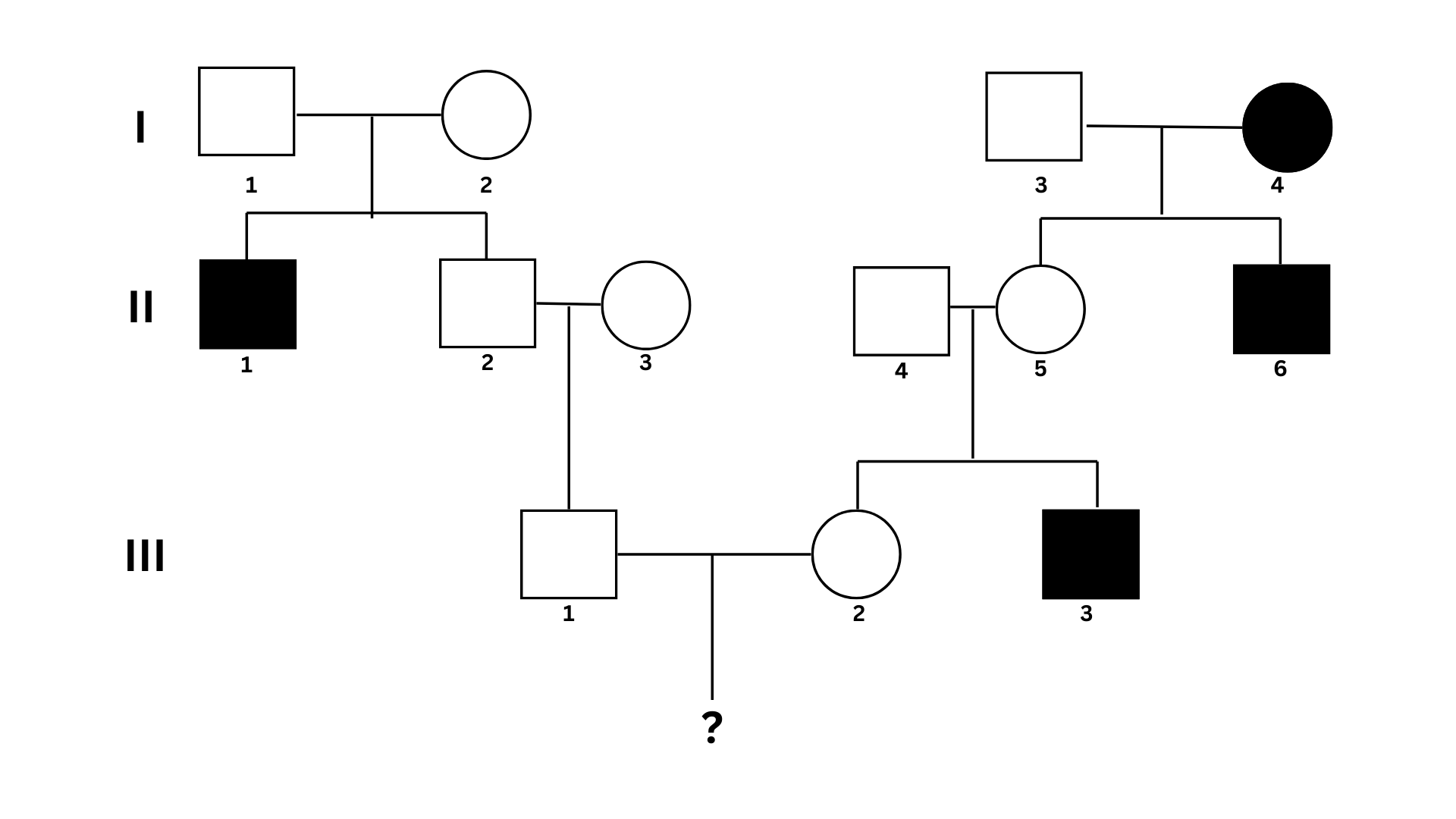7.3 – Application: Practicing Pedigree Analysis
Practicing Pedigree Analysis (text version)
- Gender Inclusive Pedigree Symbols
Symbols: -
- a square with an up arrow on the upper left corner
- circle with up arrow on the upper left side
- triangle with an up arrow on the upper left corner
- circle with a cross on the upper left corner
- square with a cross on the upper left corner
- triangle with a cross on the upper left corner
- circle with the letter i on the upper corner
- square with the letter i on the upper corner
- triangle with the letter i on the upper left corner
| Assigned Gender | Identifies as girl/woman | Identifies as boy/man | Identifies as non-binary |
|---|---|---|---|
| Assigned female at birth | |||
| Assigned male at birth | |||
| Assigned intersex at birth |
Check your answer in footnote[1]
Determining modes of inheritance
-

Fig. 7.4a True or false? In the pedigree shown (Fig. 7.4a), generation II shows a male with the trait with an affected son. An X-linked trait cannot be passed from father to son. Therefore x-linked dominance can be ruled out as a mode of inheritance. This pedigree shows an autosomal dominant mode of inheritance.
Check your answer in footnote[2] -

Fig. 7.4b The pedigree shown (Fig. 7.4b) tracks an X-linked recessive trait. As is typical of X-linked recessive traits, only males appear to be affected. Y-linked traits also only affect males. What feature(s) of this pedigree allow you to rule out Y-linked as a mode of inheritance in this pedigree?
- Y-linked traits pass from father to son, and fathers and sons always share the same phenotype. In the X-linked pedigree shown in this figure, fathers who are affected by the trait have sons who are unaffected. This rules out Y-linkage.
- Y-linked traits pass from father to son, and fathers and sons always share the same phenotype. In the X-linked pedigree shown in this figure, fathers who are affected by the trait have sons who are unaffected. This rules out X-linkage.
- Y-linked traits pass from father to son, and fathers and sons always share the same phenotype. In the X-linked pedigree shown in this figure, fathers who are affected by the trait have daughters who are unaffected. This rules out Y-linkage.
Check your answer in footnote[3]
- Match the correct words to the blanks for the pedigree chart in Fig 7.4c:

Fig. 7.4c Words: affected, unaffected
For a daughter to be [Blank a] by an X-linked recessive trait, she must inherit the X-linked allele from both her father and mother. Her hemizygous father must also be [Blank b] by the trait if he carries the allele. In this pedigree, we see an [Blank c] daughter of an [Blank d] father, which rules out an X-linked recessive mode of inheritance.
Check your answer in footnote[4] - Why are the offspring of consanguineous matings at higher risk for rare genetic disorders?
- Rare recessive disorders are uncommon because the causative alleles are uncommon among the larger population. However, everyone likely carries at least a few rare, disease-associated alleles.
- When choosing a partner randomly, it is unlikely (but not impossible) that the partner will share the same set of rare, disease associated alleles.
- Close relations may share the same disease-associated alleles, making it more likely for offspring of a consanguineous relationship to inherit two disease-associated alleles of the same gene
Check your answer in footnote[5]
- Match the words to the correct blanks, according to the pedigree chart in Fig. 7.4d.

Fig. 7.4d Words: II-1, aa, Aa
Individuals I-1 and I-2 must both have genotype [Blank a]*Aa*, since they have an affected child (II-1) who is presumed to have genotype [Blank b]*aa*. This is also true for individual I-3, who has a child with the trait as well. I-4 has the genotype [Blank c]*aa*, since they have the trait.
Check your answer in footnote[6] - Since this is a rare trait in the population, in generation II, we assume that individual II-3 is not a carrier. If this is the case, what is the genotype of II-3? (See Fig. 7.4d)
- AA
- Aa
- aa
Check your answer in footnote[7]
- True or false? Individuals II-4 and II-5 in Fig. 7.4.d must have genotype AA since they are unaffected (click image to enlarge).
Check your answer in footnote[8] - If the final offspring (see Fig. 7.4d) is affected and exhibits the trait, individual II-2 must be a carrier of the recessive allele “a” since individual II-3 was determined to be AA. What is the probability that they inherited the “a” allele?
- 1/4
- 3/4
- 2/3
- 1/3
Check your answer in footnote[9]
- Match the words to the correct blanks according to the pedigree chart in Fig. 7.4d.
Words: 3/4, aa, 1/4
Assume individuals III-1 and III-2 have parents with the same genotypes. In each of these parental pairs, one parent is homozygous AA and the other is heterozygous ([Blank a]). The probability that III-1 and III-2 will be unaffected carriers (genotype As) is [Blank b]*.
Check your answer in footnote[10] - What is the probability that the offspring of III-1 and III-2 is affected (see Fig. 7.4d). Hint: Both parents are heterozygous.
- 3/4
- 1/2
- 1/4
Check your answer in footnote[11]
Activity source: Pedigree analysis In Chromosomes, Genes, and Traits: An Introduction to Genetics by Amanda Simons, CC BY-NC-SA 4.0
Attribution
Except where otherwise noted, this page is adapted from Pedigree analysis In Chromosomes, Genes, and Traits: An Introduction to Genetics by Amanda Simons, CC BY-NC-SA 4.0
-
↵Gender Inclusive Pedigree Symbols - Activity Solution Assigned Gender Identifies as girl/woman Identifies as boy/man Identifies as non-binary Assigned female at birth 4 5 6 Assigned male at birth 2 1 3 Assigned intersex at birth 7 8 9 - True. An X-linked trait is associated with genes located on the X chromosome. Males have one X chromosome and one Y chromosome (XY), while females have two X chromosomes (XX). When a father contributes genetic material to his child, he passes his Y chromosome to his son, which determines the male sex, and his X chromosome to his daughter. Since sons inherit the Y chromosome from their father, they do not inherit any genes located on the father’s X chromosome. Therefore, any X-linked traits or conditions carried by the father cannot be transmitted to his sons. Instead, if the father carries an X-linked trait, it can only be passed to his daughters, as they inherit his X chromosome. ↵
- a. ↵
- Blank a - affected, Blank b - affected, Blank c - affected, Blank d- unaffected ↵
- a, b & c. ↵
- Blank a: Aa, Blank b: aa, Blank c: aa ↵
- A. AA ↵
- False. AA is not the genotype for these two individuals. They are Aa since they have an affected child. II-5 inherits a dominant allele from her father and a recessive allele from her mother. ↵
- c. The probability of Aa is 2/3. ↵
- Blank a: Aa, Blank b: 1/2. ↵
- a. There is a 3/4 chance the offspring will be unaffected and a 1/4 chance of being affected. ↵

